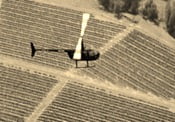This Week In Wine – 10/30/11
October 30, 2011
To Save Soggy Grapes, Winemaker Looks To Helicopter
It’s been raining for days and the crop you’re a week away from harvesting is about to mold. If you don’t dry it quickly, you will lose the crop. What do you do?
If you’re Bruce Cakebread, you call in a helicopter to be a giant grape dryer.
When rain soaked Napa Valley two weeks ago, Cakebread — the president of Cakebread Cellars in Rutherford, Calif. — used a technique occasionally employed by orange and cherry farmers. It’s just the latest example of farmers forced to take drastic measures to salvage crops in the face of extreme weather.
If mold forms on grape clusters, they can’t be picked for harvest. Fortunately for the valley’s winemakers who got drenched this month, most of the white and red varietals had already been picked. But the Cabernet Sauvignon — a tougher, more resilient varietal — still hung on the vines during the wet weather.
Click here for the full article.
My Thoughts
I’d be interested to know if it works! I’ve heard of Australian wineries doing this before, but not so much in California. Either way, it’s great publicity! Plus, what a great way to one-up your neighboring vineyards!
Leon Panetta To Toast Bin Laden’s Death With $10,000 Bottle of Wine
The U.S. government offered a $25-million bounty for Osama bin Laden, but there was a lesser-known enticement for then-CIA chief Leon Panetta: a sip or two of Chateau Lafite Rothschild 1870, one of the world’s most celebrated wines.
Last year, Panetta attended an annual New Year’s Eve gathering hosted by Monterey restaurateur Ted Balestreri, who was chided by some of his 28 guests about the $10,000 bottle of wine sitting in his wine cellar. Asked when he would finally uncork it, he answered: "When Leon catches Bin Laden." The bottle will be opened this New Years Eve.
Click here for the full article.
My Thoughts
I could make a joke here about how that bottle of Chateau Lafite Rothschild 1870 is about 5 years past its prime….but I won’t do that…
Salisbury’s "Citizen Wine Pickers" Bring in the Berries, Slowly.
When Salisbury Vineyards issued a “Call to Arms” inviting unemployed Central Coast locals to harvest its 2011 vintage, owner John Salisbury hoped to enlist a new source of vineyard labor and provide reasonably paid temporary jobs to those in need.
Despite his best intentions and persistence, his social experiment did not pan out exactly as planned. He recently sent out a summary of the season:
“We had over 80 inquiries for the jobs. We had 40 come in and fill out a five-page application. We picked 22 to come in for an interview,” he said. Four did not show up. “We took the 18 remaining and started picking on a Wednesday. That day cost us over $500 per ton, which is three times the normal (cost).” To Salisbury’s relief, “The next day, it picked up a little. I was becoming worried, because we were getting behind; the Pinot Noir was quickly getting ripe.” On the third day, he brought in a veteran, documented crew. “They lapped the citizen crew,” he reported. “The fourth day was a Saturday, and four of the citizen crew didn’t call or show up. At the end of the day, we let another six go, because they just weren’t up to the job and hadn’t showed any improvement or desire to do so. It was obvious this was their first time in the field, or else the first job ever for the younger pickers,” some of whom had been “volunteered” by their parents.
Click here for the full article.
My Thoughts
I. Freaking. LOVE! This story! It just goes to show that everyone is soooo quick to jump on closing our borders, and tightening up on illegal immigration…..right up-until the point where the price of their favorite bottle of wine doubles in price, because labor is so hard to find.
Party Over as Wine Profits Plummet in New Zealand
More than 70 New Zealand vineyards are for sale, as wine profits plummet.
Export wine prices have also slumped to a new low as the industry struggles to cope with changes wrought by a massive increase in supply of Marlborough sauvignon blanc.
Latest Overseas Merchandise Trade figures show that wine exports have more than doubled in the past four years. That includes 47 million litres exported in the three months to September, a 114% increase on the same period in 2007.
Although that has pushed the total value of New Zealand’s wine exports up past the $1 billion mark, it has been accompanied by a sharp slide in the average price per litre, a major determinant of industry profitability.
Click here for the full article.
My Thoughts
No surprises here. They’ve been resting on their laurels for far too long! Instead of looking at new ways to innovate and market their wines; winemakers have simply sat-back, praying that wine-drinkers tastes won’t change, and that people will keep buying their wines.
I have zero sympathy.















